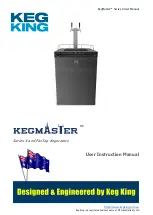
13
Symptom
Possible solution
The overheating LED is on.
1. Check the welding current and welding time. Refer to the manual, and
operate according to the duty cycle requirement.
2. Check the running status of the fan when welding. If the fan does not
work, check if the power supply of the fan is 220V: If the power supply is
normal, check the fan; if the power supply is abnormal, check the
connecting cable of the power supply.
3. Replace the thermal switch if it is damaged.
The power LED is off, and there is no output
current.
1. Check if the fan works. If it does not work, it indicates that the power
cord is not in good contact.
2. If the fan works, it indicates that the control PCB PK-131 inside the
machine fails.
There is no response when pushing the
torch trigger, and the protection LED is off.
1. Check if the gun trigger is in good contact.
2. Check if the welding torch is well connected to the European connector,
and check the control jack of the European connector.
3. The wire feed PCB PH-119 inside the machine fails.
When torch trigger is pressed, wire feeder
works and gas comes out, but there is no
output current, and the protection LED is off.
1. Check if the cable to the workpiece is in good contact.
2. Check if the quick plug is connected to correct quick socket.
3. Check the welding torch for damage.
4. The control PCB PK-131 inside the machine fails.
There is output current when pushing the
torch trigger to feed gas, but the wire feeder
does not feed wire.
1. Check the wire feeder for clogging or damage.
2. Check the contact tip of welding torch for clogging or damage.
3. The wire feed PCB PH-119 inside the machine fails.
Welding can be carried out when pushing
the torch trigger, but the voltage cannot be
adjusted.
1. Check if the voltage feedback wire inside the machine is in good
condition.
2. The control PCB PK-131 inside the machine fails.
Welding current is unstable.
1. Check the pressure arm on the wire feeder for proper pressure.
2. Check if the drive roll matches the wire size being used.
3. Check the contact tip of the welding torch for wear. Replace it and
tighten it if necessary.
4. Check the welding wire for good quality.
5. Check if the torch cable is too twisted.
6. Check if the quick plug is loose.
Summary of Contents for JM-350C
Page 16: ...Electrical schematic 7 15 VDC ...





































